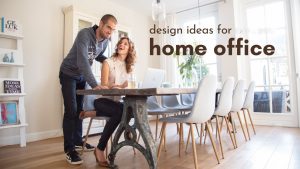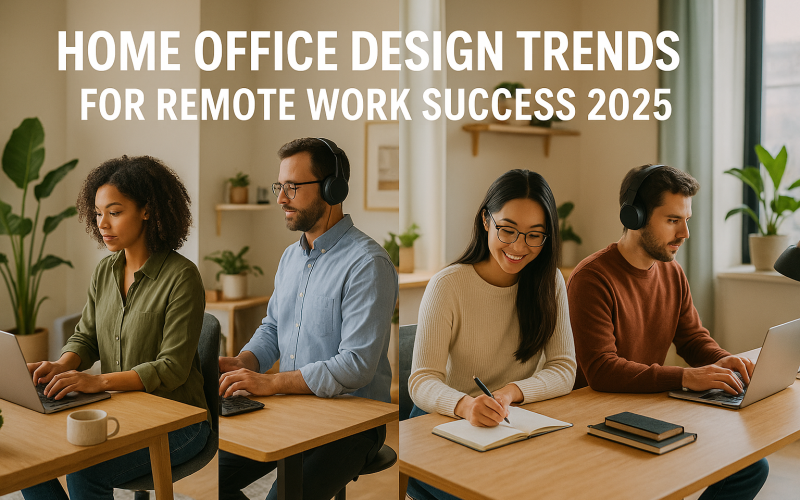Introduction
With remote work becoming a permanent part of many people’s lives, designing an effective home office has never been more important. In 2025, more professionals are working from home than ever before, making it crucial to create a space that encourages productivity, focus, and well-being.
The home office design trends for 2025 are all about balancing functionality and comfort. Whether you’re setting up a dedicated workspace in a small apartment or renovating an entire room, the right design choices can make a huge difference in your full time remote work success.
In this article, we’ll explore the latest home office design trends and offer tips on how to create a workspace that enhances your productivity and overall work-life balance.
What Makes a Good Home Office Design?

A good home office design is more than just a desk and a chair. It’s about creating an environment that supports your work style, helps you stay focused, and promotes creativity. In 2025, the focus is on ergonomics, multifunctional spaces, and personalization.
To be successful in remote work, your home office spaces should have the following features:
- Comfortable seating for long hours
- Efficient lighting that reduces eye strain
- Smart organization for a clutter-free workspace
- Aesthetic elements that inspire creativity and relaxation
Now, let’s dive into the top home office design trends for 2025.
Top Home Office Design Trends for Remote Work 2025

1. Ergonomic Furniture for Comfort and Health
Working from home often means sitting at a desk for long periods. In 2025, the emphasis is on ergonomic furniture that supports good posture and reduces the risk of discomfort or injury. Ergonomic chairs, desks, and accessories are no longer optional but a necessity for a successful home office.
Ergonomic Chairs and Desks
The best ergonomic chairs feature adjustable height, lumbar support, and armrests that reduce strain on your back, neck, and shoulders. Sit-stand desks are also gaining popularity, allowing you to alternate between sitting and standing throughout the day. This promotes better circulation and helps avoid the stiffness that comes with long hours of sitting.
Accessories for Comfort
In addition to ergonomic furniture, accessories like keyboard trays and footrests can help create a more comfortable workspace. These tools help improve posture and keep you comfortable during long work sessions.
2. Multifunctional Spaces for Maximum Efficiency
In many homes, space is limited, and you may need your home office to serve more than one purpose. Multifunctional spaces are one of the most important design trends for 2025, as people look for ways to make the most out of smaller spaces.
Foldable and Modular Furniture
Modular furniture allows you to easily rearrange your space to suit your needs. For example, a foldable desk can be tucked away when not in use, or a modular bookshelf can double as a room divider to separate your work area from your living space.
Dual-Purpose Rooms
Consider combining your home office with other rooms, such as a guest room or living room. A foldable desk or wall-mounted workstation can quickly convert a living area into an office when needed.
3. Smart Lighting for a Productive Environment
Lighting plays a huge role in your home office design. In 2025, smart lighting systems are becoming more popular as they allow you to control the lighting in your workspace based on the time of day and the work you’re doing.
Natural Light
Whenever possible, position your desk near windows to take advantage of natural light. Exposure to daylight helps regulate your circadian rhythm and boosts mood and energy levels.
Adjustable LED Lights
For evening work, LED lights are a great option. Many LED lights now come with adjustable brightness and color temperature settings, allowing you to choose cool, bright light for focus or warm, soft light for relaxation.
Desk Lamps with Features
Desk lamps with built-in features like USB ports for charging or adjustable color temperature can help optimize your workspace for productivity.
4. Personalization and Comfort
Your home office should feel like a space that is uniquely yours, reflecting your style and personality. In 2025, the trend is all about personalization—incorporating items that inspire and motivate you.
Plants for a Fresh Touch
Adding plants to your workspace has multiple benefits. They improve air quality, reduce stress, and add a calming aesthetic. Consider low-maintenance plants like succulents, snake plants, or pothos, which thrive in small spaces and require minimal care.
Artwork and Personal Items
Incorporate artwork, photographs, or decorative items that motivate or inspire you. Surrounding yourself with things you love can boost creativity and morale during long workdays.
5. Technology Integration for Seamless Workflows
In 2025, technology is an integral part of home office design. From smart devices to wireless charging stations, technology is helping create more efficient and streamlined workspaces.
Wireless Charging Stations
Gone are the days of tangled cables. Wireless charging stations for your phone, laptop, and other devices can help you keep your workspace neat and organized.
Smart Assistants and Automation
Smart assistants like Amazon Alexa or Google Assistant can help you manage tasks, set reminders, or control lighting and temperature. Automating certain tasks allows you to focus on what really matters—your work.
Future of Home Office Design Trends

Looking ahead to 2025 and beyond, home office design will grow smarter and more flexible. We’ll see affordable modular furniture that adapts to small spaces and changing needs. Smart lighting systems will adjust color and brightness based on time of day and task. Virtual reality “workstations” could create private work bubbles in shared rooms. Materials will become more eco-friendly, with recycled fabrics and low-VOC paints. As technology and design merge, remote workers everywhere will enjoy home offices that blend comfort, health, and productivity seamlessly.
Comparative Table: Key Features of Home Office Design Trends in 2025
| Feature | Benefits | Examples |
|---|---|---|
| Ergonomic Furniture | Supports comfort and posture, reduces physical strain | Adjustable chairs, sit-stand desks, ergonomic accessories |
| Multifunctional Spaces | Maximizes space, adapts to different needs | Foldable desks, modular furniture, dual-purpose rooms |
| Smart Lighting | Enhances productivity, reduces eye strain, and boosts mood | LED desk lamps with adjustable brightness, natural light focus |
| Personalization | Creates an inspiring and comfortable environment | Artwork, plants, personal decor |
| Sustainability | Reduces environmental impact, promotes eco-friendly choices | Recycled furniture, low-energy tech, sustainable materials |
| Technology Integration | Streamlines work processes, increases efficiency | Wireless charging, smart assistants, tech-friendly furniture |
Conclusion: Designing Your Perfect Home Office in 2025
Creating the ideal home office is essential for remote work success in 2025. By focusing on work environment comfort, functionality, and personalization, you can design a space that increase productivity while also promoting well-being. Whether you’re adding ergonomic furniture, smart lighting, or personal touches, there are endless ways to enhance your workspace.
As work remotely continues to grow, a well-designed home office will not only make your daily tasks or project management easier but also help you stay motivated and inspired. Embrace these home office design trends to set yourself up for success in 2025 and beyond.
Call to Action
Are you ready to design your ideal home office for remote work success? Explore our resources for more home office design ideas and create a workspace that works for you in 2025!












